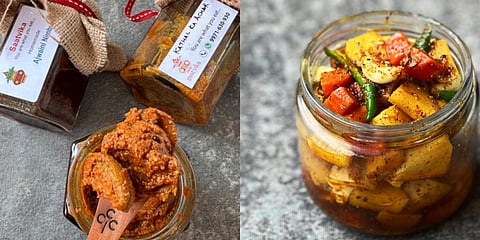

As a kid, I'd ask my mother why she never made pickles. She'd always say that it is because my naani - her mother - made the best ones. True to her word, naani's hands were magic - every summer was spent making a variety of aam [mango], nimbu [lemon], and kathal [jackfruit] pickles.
There was always something for everyone - from the Punjabi-style aam ka achaar, to kacche aam [dry mango] ki chutney, heeng [asafoetida] waala aam ka achaar and meetha aam [sweet mango] ka achaar. But, while the taste is what attracted me to the achaars back as a kid, what draws me to them today are memories.
When my daadi [paternal grandmother] suddenly passed away 20 years ago, none of us were prepared for that moment. A year after her passing away, we discovered a jar left behind by her in a corner of our kitchen. It was a jar of nimbu achaar that she had made for us, before she left.
As I grew up, I understood just how important a jar of pickle this is. Not only was daadi known within our community for her nimbu achaar - this was a way for the family to remember her decades later. Incidentally, it also had to be a jar of achaar, something that could be preserved for years. It is almost as if she knew what she was leaving behind.
Such is the magic of the humble achaar, which by definition is a simple taste enhancer that can rescue a bland dal or a boring subzi when you crave something chatpata [tangy]. Given my run-ins with pickles since I was a kid, I always associated them with my grandmothers. When I looked outside my family, I realised that the art and memories behind pickles was similar for many.
For instance, every season shift through the years would see the women of the mohalla [community] come together to chop tender baby mangoes with a sarota [nutcracker], and spread them on a sheet under the sun. This was their own language - their inside jokes, their ways to express creativity.
Soon, the act of making pickles paved the way to empower women across communities. In 1964, Pushpawati Khaitan founded Nari Shakti Kendra (NSK) in Ghaziabad to provide livelihoods to the women of the local community. Here, they made homeground masalas and traditional pickles. Today, they continue to ferry their fare through their online store, led by Jaya Bajaj.
Sunili Bhatia of Gurugram, a certified corporate trainer, is another example of the feminine touch to the act of pickle-making. Today, her hobby has evolved into a homegrown business under the label Saatvika. Some of the pickles she sells are so rare that you wouldn’t find them anywhere outside familial secrets.
This defines the joyous magic behind the humble achaar.
It is never the star of the show, but when you look back, you find memories from simpler times - unadulterated even today, as if preserved just the way my daadi’s last jar of nimbu achaar has been for two decades now.
(The author is a food writer who is known for her research-based articles through her blog 'Delectable Reveries')